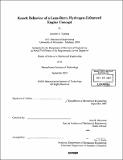| dc.contributor.advisor | John B. Heywood. | en_US |
| dc.contributor.author | Topinka, Jennifer A. (Jennifer Ann), 1977- | en_US |
| dc.contributor.other | Massachusetts Institute of Technology. Dept. of Mechanical Engineering. | en_US |
| dc.date.accessioned | 2006-11-06T18:16:30Z | |
| dc.date.available | 2006-11-06T18:16:30Z | |
| dc.date.copyright | 2003 | en_US |
| dc.date.issued | 2003 | en_US |
| dc.identifier.uri | http://hdl.handle.net/1721.1/34351 | |
| dc.description | Thesis (S.M.)--Massachusetts Institute of Technology, Dept. of Mechanical Engineering, 2003. | en_US |
| dc.description | Includes bibliographical references (p. 89-91). | en_US |
| dc.description.abstract | Experiments to identify the knock trends of lean gasoline-air mixtures, and such mixtures enhanced with hydrogen (H2) and carbon monoxide (CO), were performed on a single-cylinder research engine with boosting capability. The experimental method used to investigate knock trends consisted of determining the octane number (ON) of the primary reference fuel (mixture of isooctane and n-heptane) supplied to the engine that just produced audible knock. All tests were completed at 1500 rpm, MBT spark timing, with coolant temperature at fully warmed-up conditions and intake air temperature at 200 C. Various relative air-fuel ratio (lambda) sweeps were performed, while holding different parameters constant. First, testing with primary reference fuels investigated knock limits of lean operation; selected tests were then repeated with H2 and CO-enhancement. These mixtures simulated 15% and 30% of the engine's gasoline being reformed in a plasmatron fuel.reformer. Experimental results show that leaner operation does not decrease the knock tendency of an engine under conditions where a fixed output torque is maintained; rather it slightly increases the octane requirement. The onset of knock does decrease with lean operation when the intake pressure is held constant, but engine torque is then reduced. When H2 and CO are added to the mixture, the knock susceptibility is reduced, as illustrated by a decrease in the measured octane number of the primary reference fuel resulting in knock. Experiments conducted with the addition of H2 show similar trends, but to a lesser degree. Therefore, both H2 and CO act as octane enhancers when added to a hydrocarbon-air mixture. The extent to which H2 and CO improve the knock resistance of a mixture can be estimated by finding the bond-weighted octane number for the mixture of fuels. To substantiate these. results, a chemical kinetic ignition model was used to predict autoigntion of the end-gas for various conditions and fuel-air mixtures. Predicted model trends of knock onset partially agree with experimental observations. A comprehensive isooctane chemistry mechanism was used to demonstrate that H2 and CO-enhancement are effective in lengthening the ignition delay, and thereby reduce knock tendency. | en_US |
| dc.description.statementofresponsibility | by Jennifer A. Topinka. | en_US |
| dc.format.extent | 116 p. | en_US |
| dc.format.extent | 6481799 bytes | |
| dc.format.extent | 6486619 bytes | |
| dc.format.mimetype | application/pdf | |
| dc.format.mimetype | application/pdf | |
| dc.language.iso | eng | en_US |
| dc.publisher | Massachusetts Institute of Technology | en_US |
| dc.rights | M.I.T. theses are protected by copyright. They may be viewed from this source for any purpose, but reproduction or distribution in any format is prohibited without written permission. See provided URL for inquiries about permission. | en_US |
| dc.rights.uri | http://dspace.mit.edu/handle/1721.1/7582 | |
| dc.subject | Mechanical Engineering. | en_US |
| dc.title | Knock behavior of a lean-burn hydrogen-enhanced engine concept | en_US |
| dc.type | Thesis | en_US |
| dc.description.degree | S.M. | en_US |
| dc.contributor.department | Massachusetts Institute of Technology. Department of Mechanical Engineering | |
| dc.identifier.oclc | 54629063 | en_US |
